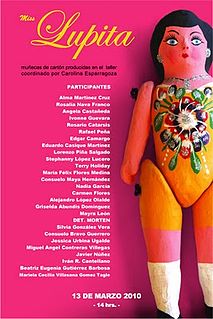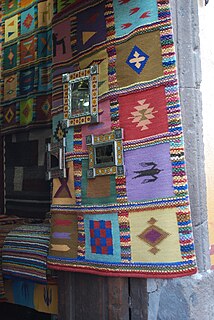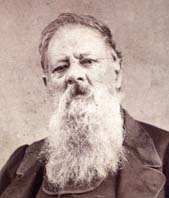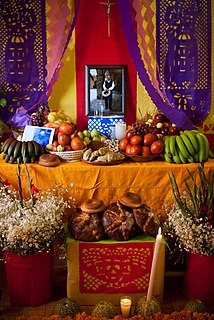
José Guadalupe Posada was a Mexican political printmaker and engraver whose work has influenced many Latin American artists and cartoonists because of its satirical acuteness and social engagement. He used skulls, calaveras, and bones to make political and cultural critiques. Among his famous works was La Catrina.

La Calavera Catrina or CatrinaLa Calavera Garbancera is a 1910–1913 zinc etching by the Mexican printmaker, cartoon illustrator and lithographer José Guadalupe Posada. She is offered as a satirical portrait of those Mexican natives who, Posada felt, were aspiring to adopt European aristocratic traditions in the pre-revolution era. La Catrina has become an icon of the Mexican Día de Muertos, or Day of the Dead.
Demián Flores Cortés is a contemporary Mexican artist who works in multiple media. He has worked in graphic arts, painting, serigraphy and more producing work which often mixes images from his rural childhood home of Juchitán with those related to modern Mexico City. It also often including the mixture of pop culture images with those iconic of Mexico’s past. Much of Flores’ work has been associated with two artists’ workshops he founded in Oaxaca called La Curtiduría and the Taller Gráfica Actual. This work has included events related to the 2006 uprising in Oaxaca and the restoration of an 18th-century church. His work has been exhibited in Mexico City, Europe, Guatemala and Cuba.

The Linares family in Mexico City are among the best known practitioners of a craft known as “cartonería” or the use of papier-mâché to create hard sculptured objects. They have an international reputation for the creation of forms such as skeletons, skulls, Judas figures and fantastical creatures called alebrijes. While the family’s history in the craft can be traced back as far as the 18th century, it was the work of Pedro Linares, who invented the alebrijes, that made the family famous. Pedro’s work became internationally famous through the patronage of artists of Diego Rivera and the promotion of it at the 1968 Olympic Games and through documentaries. Pedro died in 1990, but his sons and grandsons continue with the craft, which is sold internationally and have been exhibited in museums in various countries.

Carlomagno Pedro Martínez is a Mexican artist and artisan in “barro negro” ceramics from San Bartolo Coyotepec, in the Mexican state of Oaxaca. He comes from a family of potters in a town noted for the craft. He began molding figures as a child and received artistic training when he was 18. His work has been exhibited in Mexico, the U.S. and Europe and he has been recognized as an artist as well as an artisan. Today, he is also the director of the Museo Estatal de Arte Popular de Oaxaca (MEAPO) in his hometown. In 2014, Martínez was awarded Mexico's National Prize for Arts and Sciences
María Teresa Pomar was a collector, researcher and promoter of Mexican handcrafts and folk art along with the communities associated with them. She began as a collector then working with museums to promote handcrafts and then working to found a number of museums and other organizations to the same purpose. She became one of Mexico’s foremost experts on the subject, serving as director of different organizations and judge at competitions in Mexico and abroad. She died in 2010 while she was serving as the director of the Museo Universitario de Artes Populares of the University of Colima, which changed its name to honor her.
Desiderio Hernández Xochitiotzin was a Mexican artist best known for his large-scale mural work inside the State Government Palace in the state of Tlaxcala, Mexico, the last large scale mural of the Mexican muralism movement.

Miss Lupita is a project based in Mexico City with the aim of reviving the traditional craft of Lupita dolls. The dolls originated in the late 18th and early 19th century as a way to cheaply copy more expensive imported dolls for poorer families. The dolls are made from a very hard form of papier-mâché called “cartonería” which is also used to create alebrijes and skeletal figures for Day of the Dead. However, the craft has waned with the only workshops making and selling them located in Celaya in the state of Guanajuato, mostly as collector’s items. The project’s aim was to create more contemporary designs through a series of free workshops to the public. The resulting dolls have been displayed in Mexico City, Japan and Portugal and featured in a number of Mexican publications.

The Mexico City Alebrije Parade is an annual event to honor Mexican handcrafts and folk art, especially a hard kind of papier-mâché called “cartonería” and the creation of fantastic figures with it called “alebrijes.” Alebrijes are chimera-like creatures credited to artisan Pedro Linares painted in bright colors. The alebrijes for the parade are larger than anything Linares created, up to four meters in height and three meters in width. The parade begins on midday on a Saturday in late October in the historic center of Mexico City. The giant creatures are accompanied by musicians, clowns, people in costume and more, giving the event a Carnival-like atmosphere. After the parade the creations are judged with prizes awarded. There are also related literary and musical compositions.

Traditional Mexican handcrafted toys are those made by artisans rather than manufactured in factories. The history of Mexican toys extends as far back as the Mesoamerican era, but many of the toys date to the colonial period. Many of these were introduced as teaching tools by evangelists, and were associated with certain festivals and holidays. These toys vary widely, including cup and ball, lotería, dolls, miniature people, animals and objects, tops and more—made of many materials, including wood, metal, cloth, corn husks, ceramic, and glass. These toys remained popular throughout Mexico until the mid-20th century, when commercially made, mostly plastic toys became widely available. Because of the advertising commercial toys receive and because they are cheaper, most traditional toys that are sold as handcrafts, principally to tourists and collectors.

Alfonso Castillo Orta was a Mexican potter from the ceramics town of Izúcar de Matamoros, Puebla, whose work made the ceramics of this area internationally known. He was particularly known for his trees of life sculptures and received various awards for his work, including the Premio Nacional de Ciencias y Artes in 1996. He taught the craft to his wife and five children who continue to create pieces in his style in the family workshop.

Guanajuato handcrafts and folk art are mostly of European origin although some indigenous work still survives in some communities. The most notable craft is the making of glazed mayolica pottery, followed by handmade traditional toys of various materials, especially a hard paper mache called cartonería. While handcrafts are not a large an industry here as in some other states, it does have several major handcraft markets which sell to tourists and foreign residents. Other handcraft traditions include wrought iron work, tin and glass, wood carving and leather working.

Handcrafts and folk art in Mexico City is a microcosm of handcraft production in most of the rest of country. One reason for this is that the city has attracted migration from other parts of Mexico, bringing these crafts. The most important handcraft in the city is the working of a hard paper mache called cartonería, used to make piñatas and other items related to various annual celebrations. It is also used to make fantastic creatures called alebrijes, which originated here in the 20th century. While there are handcrafts made in the city, the capital is better known for selling and promoting crafts from other parts of the country, both fine, very traditional wares and inexpensive curio types, in outlets from fine shops to street markets.

Puebla handcrafts and folk art is handcraft and folk art from the Mexican state of Puebla. The best-known craft of Puebla is Talavera pottery—which is the only mayolica style pottery continuously produced in Mexico since it was introduced in the early colonial period. Other notable handcraft traditions include trees of life from Izúcar de Matamoros and amate (bark) paper made by the very small town of San Pablito in the north of the state. The state also makes glass, Christmas tree ornaments, indigenous textiles, monumental clocks, baskets, and apple cider.

Adalberto Alvarez Marines is a Mexican artist and artisan who specializes in creating sculptures and other works in hard paper mache, called cartonería in Mexican Spanish. As a child, Alvarez began drawing and writing, with some success in publishing illustrations and stories. In his mid twenties, he discovered cartoneria and shifted his artistic work to this medium, first on a personal basis while working at a factory until in 1994, when he dedicated himself to the craft full-time. Alvarez's work is distinct in Mexican cartoneria because of its often non-traditional themes and artistic sense, often classed as art, rather than handcraft. With the exception of alebrijes and skeletal figures, Alvarez avoids traditional forms in favor of exploring what can be done with the medium, focusing on sculpture, decorative items and furniture. He was named a "grand master" of Mexican folk art in 2014 and has exhibited his work in Mexico and the United States. However, he does not like to spend time in exhibition and promotion, establishing his own Cartoneria Museum at his home in Santa Catarina Ayotzingo, Chalco, State of Mexico

José Agustín Arrieta was a Mexican genre painter or costumbrista painter known for his scenes of everyday life in nineteenth-century Puebla, the city in which he lived most of his life. He was most prolific, however, as a still life painter, depicting many typical Mexican foods and dishes.


























